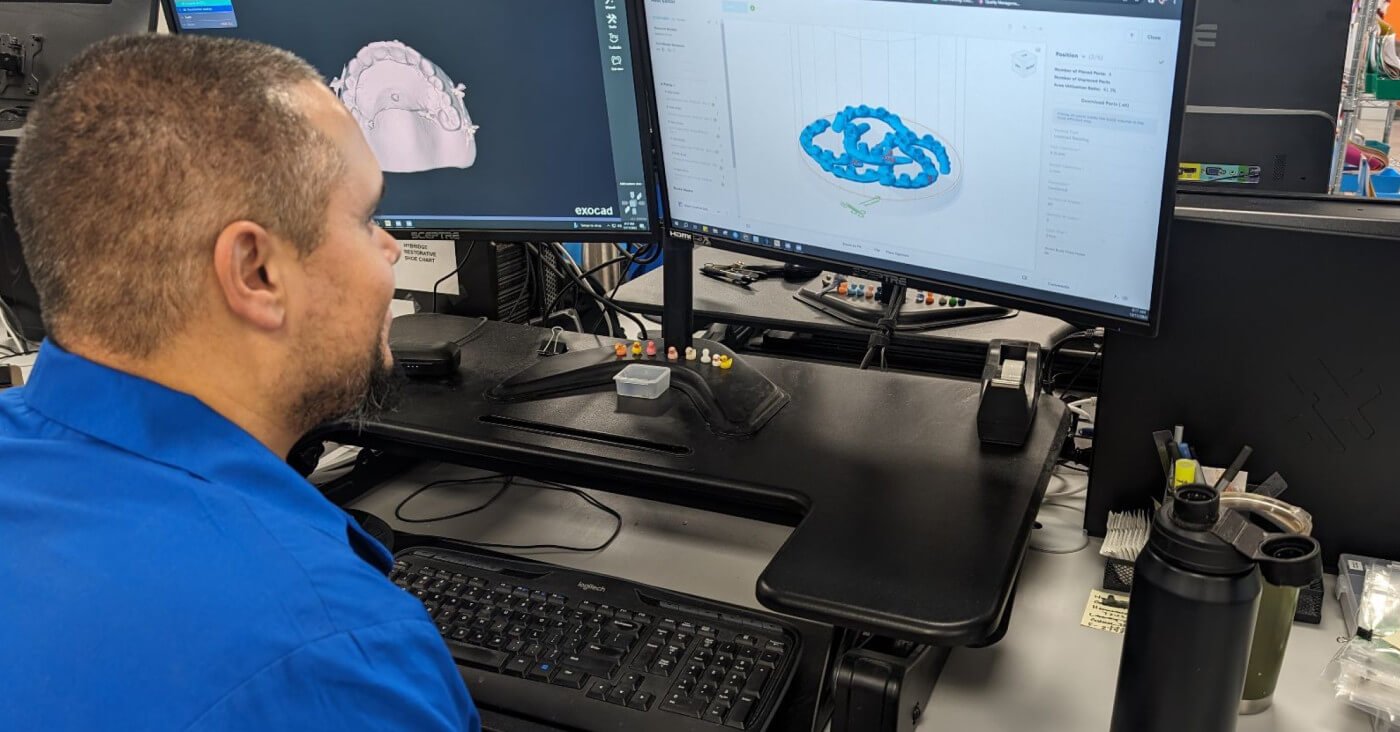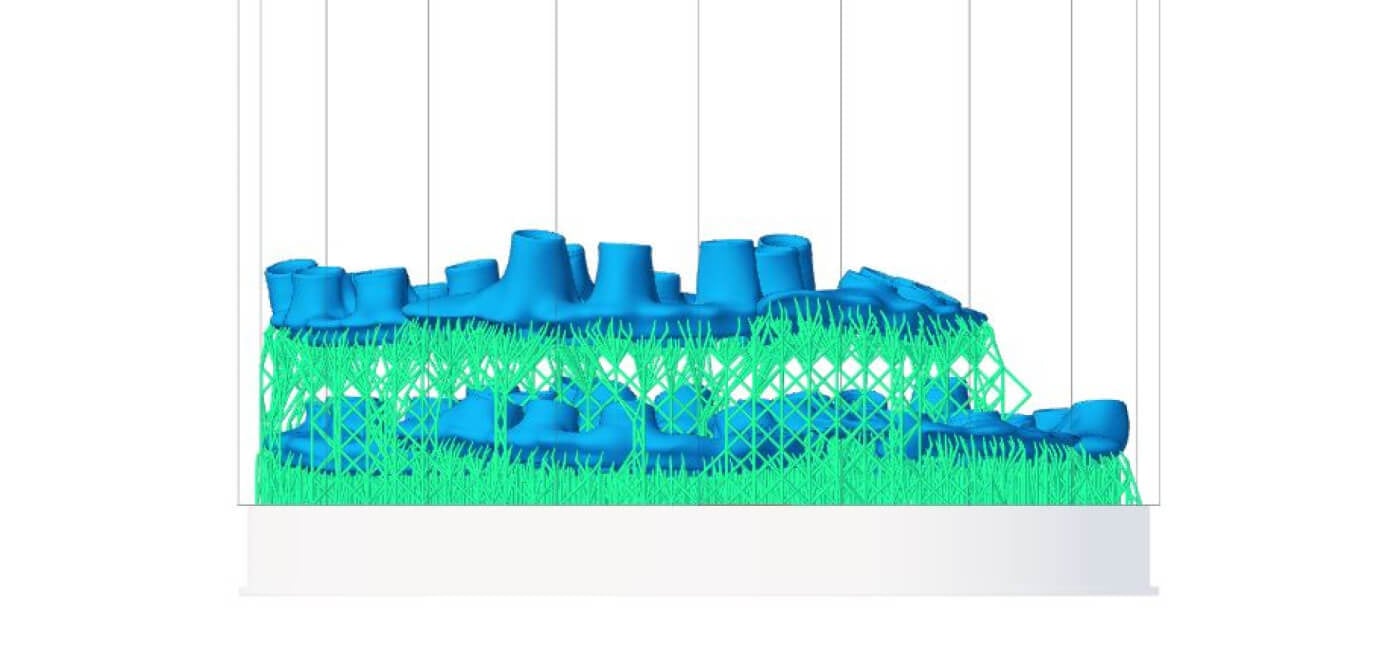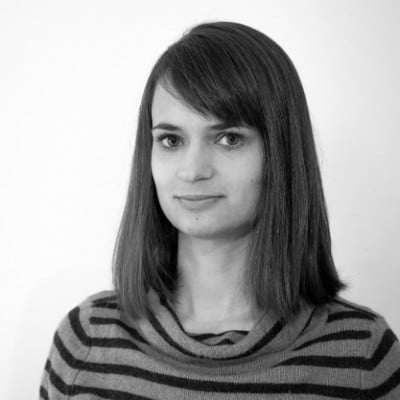Hybridge Dental Implants achieves accurate, fast, and predictable digital production with Oqton Manufacturing OS
Up and down the US dentists are seeing patients with a complex dental problem – multiple teeth loss. Sometimes the best course of action is full arch restoration, a treatment where all the teeth are replaced with prosthetic teeth supported by four to six implants. It’s an elaborate procedure, requiring a lot of planning and lengthy dental appointments.
With a clear understanding of the benefits to simplifying this process, both for the patient and the dentist, Hybridge Dental Implants, a dental lab based in Rochester, New York, put its mind to developing a better solution.
The result was a repeatable protocol that’s easy for a dentist to follow and delivers high-end results for patients in few visits. A core element of the solution’s success is using metal 3D printing and Oqton Manufacturing OS to automate the process.
Multi-layered nesting enhances dental 3D printing productivity
Last year Hybridge Dental Implants printed almost 2,000 cobalt-chrome screw-retained bars and metal foundation guides on their two Trumpf TruPrint machines. The guides go into a patient’s mouth to show the doctor how much bone they need to reduce for the implant to fit well.
Hybridge’s CAD Designer, Erick Rodriguez, produces 25 to 30 pieces a day, usually in two multilayer nests that machines print overnight.
He achieved this level of productivity thanks to the unique capabilities of Oqton’s software and input from its support team. “Oqton helped us go from a single nesting platform with two to five pieces to multilayer nesting with 10 to 16 pieces, which is a significant difference,” Rodriguez explains. “For me as the person running those machines, it has really saved a lot of time and allowed me to do more design.”
Doing a single-layer nest requires additional steps that Rodriguez simply couldn’t automate. He had to flip the machine, which took about 20 minutes, two or three times a day. “It quickly adds up, so you can see how doing a multilayer print overnight on two machines saves us a lot of time,” he says.

Hybridge’s CAD Designer, Erick Rodriguez, produces 25 to 30 pieces a day with two TruPrints and Oqton Manufacturing OS
Same resources, bigger production and higher accuracy
When it comes to the overall impact that Oqton Manufacturing OS made on the business, Christina Rivet, Digital Director at Hybridge Dental Implants, identifies several advantages. “We've had increased production, higher accuracy, we have been able to utilize the staff in different ways instead of hiring new people. Our product is more consistent and that's in part because Oqton gave us more predictability."
Rivet goes further back in Hybridge’s past to give a complete picture of how their efficiency changed. “If we compare our casting workflow to printing with Oqton Manufacturing OS, we actually gained days. It would normally take us two to three days to invest the bars, cast them, break them out, and finish them. Now the design is done on day two, it's printed by day three and out to the floor. It's such a more efficient and accurate workflow,” Rivet enthuses.
Each bar requires about an hour’s worth of labour when Hybridge uses Oqton’s software, while with casting it would take anywhere between four and five hours to do that. “Multiply that by 1900, which is how many bars we manufactured last year, and you know we’re saving a lot,” she says.
When they switched to metal additive manufacturing, Hybridge immediately went for Oqton’s software, going on a recommendation from Trumpf, the machine manufacturer. However, they did use two other software solutions back when they were doing wax printing. Even though they’re well-known software brands in 3D printing, Rivet describes working with them as ‘arduous’ and requiring a user with a deep understanding of engineering software.
She had to manually import all the files and create a job. Because the software developer didn’t partner with a lot of different printers, they had to manually create their own platform, place and orient the pieces. “You had to look at every, single, piece and check that every single area is supported – otherwise, it would fail,” Rivet explains.
She finds Oqton Manufacturing OS to be much easier to use in comparison, in part because the AI helps move things along faster. For example, Hybridge’s CAD designer relies almost entirely on Oqton’s automated supports generation which he occasionally tweaks. Rodrigez explains, “Most of the time, the software populates the supports automatically and they’re pretty much right where we need them to be. 99% of the time we don’t have to make any sort of changes.”
As their confidence in the software grew, the team discovered new capabilities that unlocked additional savings and process improvements. Lattice supports are a perfect example. “Instead of the machine building a million tiny straight vertical supports, with Oqton Manufacturing OS we can build a lattice structure which covers a wider area. We use fewer supports to get the same result,” Rivet says. “With lattices, we use less powder and we can get up into those higher layers with more accuracy and fewer touch points.”
The critical role of customer support
One of the biggest perks of Oqton, in her view, is the customer support. “Any time that we've had a question, any time that we needed support in any fashion, any time that we've suggested an upgrade, it hasn't fallen on deaf ears – and that is huge in the industry,” Rivet says. “You're only as good as the software and the machines that you're using and that’s why you need to be able to depend on your partners. Having someone immediately available through online chat or an email away has really been invaluable to us.”
Support also helped Hybridge get their metal additive production off the ground. “We sent the team the pieces and they created an initial route model and orientated the part in a way that could be optimal. We checked it and fed back to them, in order to land on an ideal solution,” Rivet says.
 Layered nest shown inside Oqton Manufacturing OS
Layered nest shown inside Oqton Manufacturing OS
Print with confidence and peace of mind
Reflecting on the collaboration with Oqton so far, the only thing Rodriguez and Rivet would have done differently is to implement multi-layered nesting sooner. “We were a little shy at first to do it, but once we really sat down with the Oqton team and dialled it in, it was a success. I probably would have done it years ago,” Rodriguez says.
He now also has the peace of mind that there won’t be any unwelcome surprises in production. “It’s nice to know that at the end of the day, I can put a bunch of parts on the 3D printers, run them overnight, and be confident that the next morning everything is going to come out well,” he concludes.
Topics 
Subscribe to our newsletter
Get our best content straight in your inbox

 Marta Matvijev
Marta Matvijev